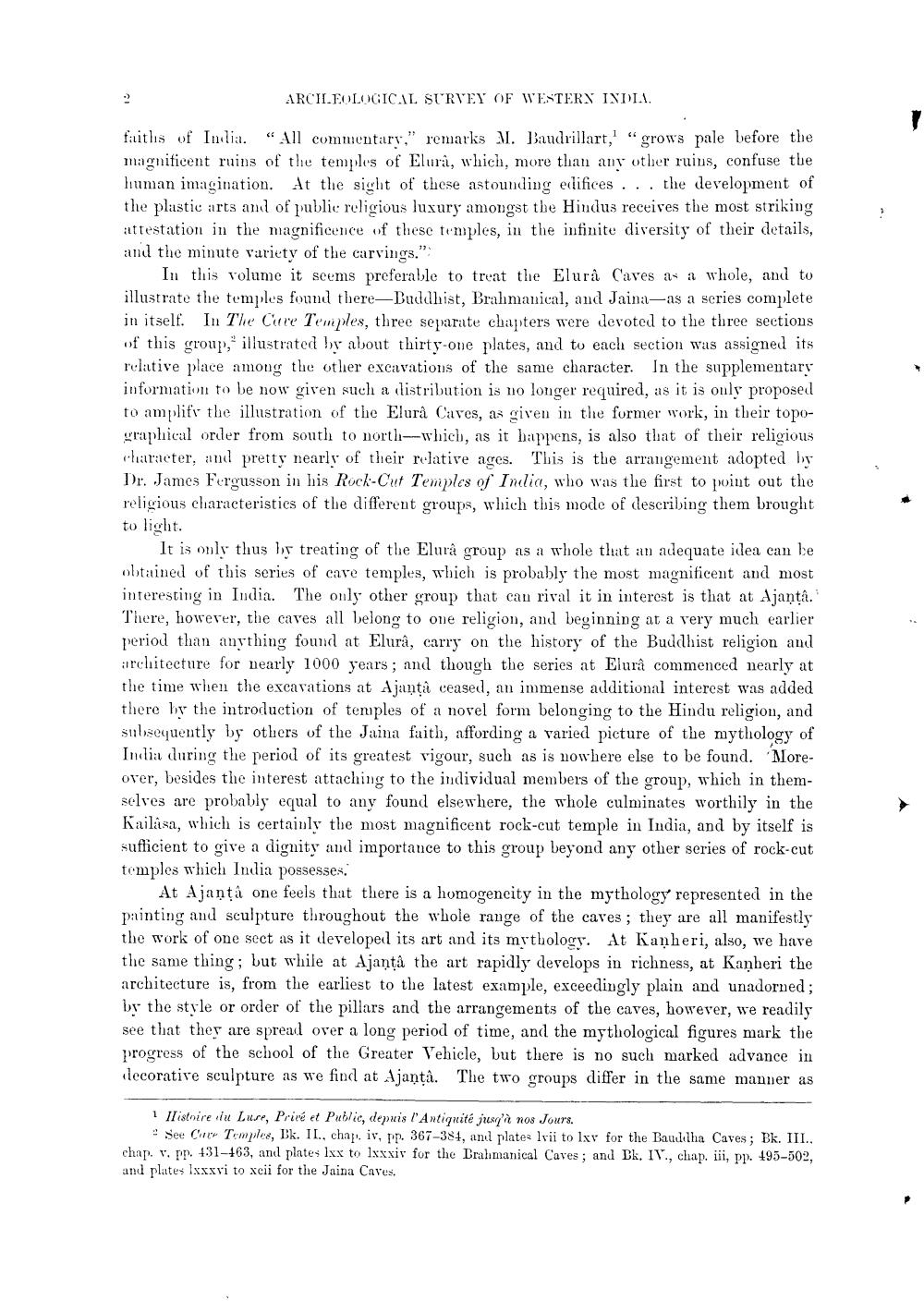________________
2
ARCHEOLOGICAL SURVEY OF WESTERN INDIA.
faiths of India. "All commentary," remarks M. Baudrillart, "grows pale before the magnificent ruins of the temples of Eluri, which, more than any other ruins, confuse the human imagination. At the sight of these astounding edifices... the development of the plastic arts and of public religious luxury amongst the Hindus receives the most striking attestation in the magnificence of these temples, in the infinite diversity of their details, and the minute variety of the carvings."
In this volume it seems preferable to treat the Elurâ Caves as a whole, and to illustrate the temples found there-Buddhist, Brahmanical, and Jaina-as a series complete in itself. In The Cure Temples, three separate chapters were devoted to the three sections of this group, illustrated by about thirty-one plates, and to each section was assigned its relative place among the other excavations of the same character. In the supplementary information to be now given such a distribution is no longer required, as it is only proposed to amplify the illustration of the Elurâ Caves, as given in the former work, in their topographical order from south to north-which, as it happens, is also that of their religious character, and pretty nearly of their relative ages. This is the arrangement adopted by Dr. James Fergusson in his Rock-Cut Temples of India, who was the first to point out the religious characteristics of the different groups, which this mode of describing them brought to light.
It is only thus by treating of the Elurâ group as a whole that an adequate idea can be obtained of this series of cave temples, which is probably the most magnificent and most interesting in India. The only other group that can rival it in interest is that at Ajanta." There, however, the caves all belong to one religion, and beginning at a very much earlier period than anything found at Elurà, carry on the history of the Buddhist religion and architecture for nearly 1000 years; and though the series at Elurà commenced nearly at the time when the excavations at Ajanta ceased, an immense additional interest was added there by the introduction of temples of a novel form belonging to the Hindu religion, and subsequently by others of the Jaina faith, affording a varied picture of the mythology of India during the period of its greatest vigour, such as is nowhere else to be found. Moreover, besides the interest attaching to the individual members of the group, which in themselves are probably equal to any found elsewhere, the whole culminates worthily in the Kailasa, which is certainly the most magnificent rock-cut temple in India, and by itself is sufficient to give a dignity and importance to this group beyond any other series of rock-cut temples which India possesses
At Ajantà one feels that there is a homogeneity in the mythology represented in the painting and sculpture throughout the whole range of the eaves; they are all manifestly the work of one sect as it developed its art and its mythology. At Kapheri, also, we have the same thing; but while at Ajanta the art rapidly develops in richness, at Kanheri the architecture is, from the earliest to the latest example, exceedingly plain and unadorned; by the style or order of the pillars and the arrangements of the caves, however, we readily see that they are spread over a long period of time, and the mythological figures mark the progress of the school of the Greater Vehicle, but there is no such marked advance in decorative sculpture as we find at Ajantâ. The two groups differ in the same manner as
1 Histoire du Lure, Privé et Public, depuis l'Antiquité jusq'à nos Jours.
See Cave Temples, Bk. II., chap. iv, pp. 367-384, and plates lvii to lxv for the Bauddha Caves; Bk. III.. chap. v. pp. 431-463, and plates lxx to lxxxiv for the Brahmanical Caves; and Bk. IV., chap. iii, pp. 495-502, and plates lxxxvi to xcii for the Jaina Caves.




